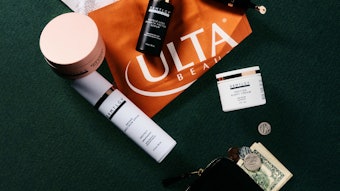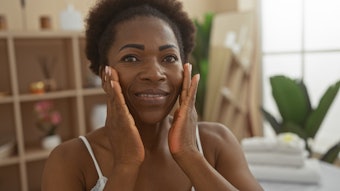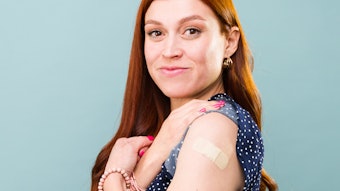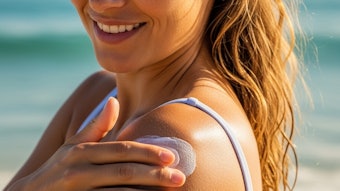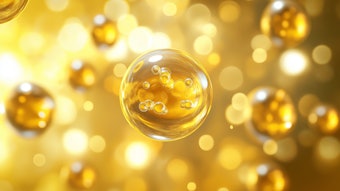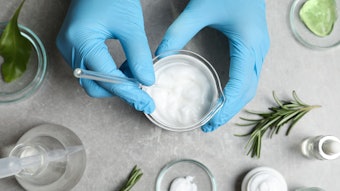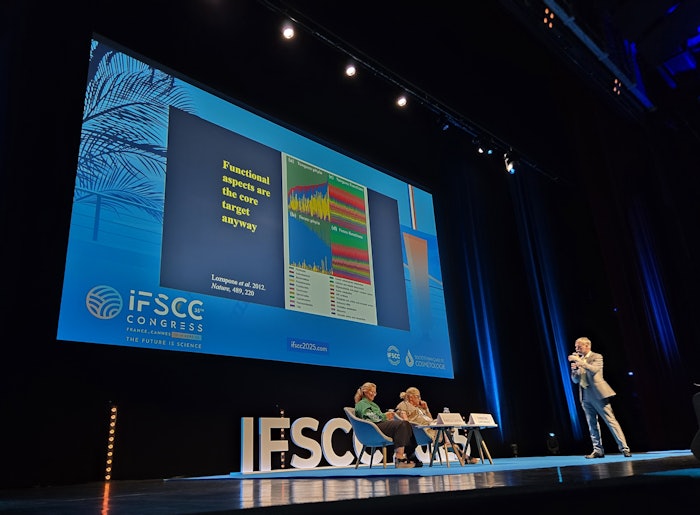
The second day of the IFSCC 2025 Congress was dedicated to holistic sciences, exploring the interconnected factors that define the health and beauty of skin and hair.
Session topics ranged from the skin microbiome and well aging, to senescence and cellular longevity, providing a vision for the future of cosmetics with presentations focused on integrated, multi-targeted approaches to enhance the performance of cosmetic products.
Out of the Box Session and Keynotes: Blue Biodiversity, Microbiome as Protective Cream, Reprogramming Aging, and Senescence
The second day of sessions commenced with thought-provoking keynotes, an "Out of the Box" session and a satellite symposium on cellular senescence as a target to reverse aging.
The Ocean's 'Secret' Language, Biomimicry and Ecosystem Health
Gilles Boeuf, of Paris Sorbonne University (Arago Laboratory, Banyuls-sur-Mer), AgroParisTech, explored the ocean's vast biodiversity as a source of inspiration for innovation in cosmetics and medicine. His "Out of the Box" presentation emphasized the concept of One Health — the interconnectedness of human, animal and ecosystem health — and how biomimicry can address challenges like climate change and pollution.
Skin Microbiota as Nature's Beauty Cream
In his keynote address, Marc-André Selosse, professor of the National Museum of Natural History and the Institut Universitaire de France, challenged the conventional view of microbes, positioning the skin microbiota as a crucial protective layer.
He examined how modern hygiene practices and cosmetic ingredients can harm this delicate ecosystem and explored pathways to restore and sustain a healthy skin microbiome.
"Everything you add to skin changes biodiversity," he said, highlighting how microbes are not individual actors but have evolved to act together and compensate for one another, creating a redundancy of functions to protect skin.
"We are reaching the limits of our own skin microbiome redundancy," he added, emphasizing it's not important to focus on the diversity of microbes, but instead their function. "The future is [about] focusing on the links between organisms," he noted.
Programming and Reprogramming Aging
 Professor Jing Qu, Ph.D., of the Chinese Academy of Sciences, Institute of Zoology, Beijing, gave her keynote presentation on cellular focused on identifying novel biomarkers and developing intervention strategies to manage senescent cells, aiming to mitigate the structural and functional decline of organs and tissues.
Professor Jing Qu, Ph.D., of the Chinese Academy of Sciences, Institute of Zoology, Beijing, gave her keynote presentation on cellular focused on identifying novel biomarkers and developing intervention strategies to manage senescent cells, aiming to mitigate the structural and functional decline of organs and tissues.
Professor Jing Qu, Ph.D., of the Chinese Academy of Sciences, Institute of Zoology, Beijing, gave her keynote presentation on cellular senescence and its role in the aging process. She focused on identifying novel biomarkers and developing intervention strategies to manage senescent cells, aiming to mitigate the structural and functional decline of organs and tissues.
Her work introduced the first multidimensional composite aging clock, comprising:
- Facial age,
- Phenotypic age,
- Transcriptomic age,
- Proteomic age,
- Metabolic age,
- Lipidomic age,
- Hormonal age,
- Immune age,
- Organ age and
- Composite biological age.
Based on factors such as fat tissue aging, which generally occurs before the age of 35; adrenal gland and lymph node accelerated aging, occurring around 35-40 years old; the aorta, heart and pancreas aging, between 40 and 45; digestive system aging, beginning around the ages of 45 to 50, etc., Qu demonstrated how plasma proteins can accurately reflect the aging of each organ, which in turn can successfully predict biological age within approximately two years' accuracy. This view could be used to support beauty-from-within interventions for aging.
Satellite Symposium: Targeting Senescence to Reverse Biological Aging
Finally, in the second day of their three-day "satellite" symposium, held in parallel with the conference tracks, the Helena Rubinstein brand hosted Audrey Gueniche, Ph.D., professor Maxime Rovere and professor Jean-Marc Lemaitre discussed cellular reprogramming with edelweiss native cells as a strategy to combat biological aging.
Session Deep Dive: Microbiome and Well-Aging
Throughout the day, parallel sessions will focus on two critical areas of holistic science: the microbiome and well-aging/longevity.
Microbiome
Microbial removal and re-introduction: Research demonstrated the reconstruction of the skin microbiome through a two-step (removal/re-introduction), AI-driven regimen.
Scalp, ethnicity, dandruff, AI-driven segmentation, species distribution, hair loss and scalp dysbiosis: This group of sessions included a discussion on the role of the scalp's bacterial profile in dandruff, and AI-driven skin segmentation for targeted formulations. In addition, the anti-aging potential of Corynebacterium was examined, as was rebalancing scalp microbiome dysbiosis to control androgenetic alopecia.
Anti-aging and formulation: Micrococcus luteus was shown to mediate anti-aging effects. In addition, the development of a bio-emulsion from a novel skin microbiome strain was presented.
Well-Aging and Longevity
In addition, sessions covered advanced research into the biological mechanisms of aging and innovative strategies to promote skin longevity and rejuvenation.
Chemometrics and aging: A study was presented using chemometrics to link visible features of facial aging to multimodal instrumental measurements in a multi-ethnic study of healthy women.
Protein signatures, energy metabolism, microfluidic models, eco-friendly exfoliation: This group of sessions presented a machine learning model for estimating biological age based on protein signatures; ameliorating skin aging by reprogramming energy metabolism via a NAMPT activator in senescent cells; microfluidic models for testing chronological aging and wound healing; and eco-friendly microbeads to exfoliate and revive skin.
Mitochondrial-driven regeneration and gravity x skin sagging: Research explored the role of mitochondria-associated endoplasmic reticulum membranes (MAMs) in cellular rejuvenation. In addition, the impact of gravity on facial skin sagging was examined using a novel custom-built imaging device: a booth that tips the subject backward up to 90 degrees.
 Remo Campiche, Ph.D., of DSM-Firmenich, noted the booth enables the measurement and visualization of facial skin displacements as a function of loose or sagging skin in 2D and 3D.
Remo Campiche, Ph.D., of DSM-Firmenich, noted the booth enables the measurement and visualization of facial skin displacements as a function of loose or sagging skin in 2D and 3D.
In his skin sagging work, Remo Campiche, Ph.D., of DSM-Firmenich, noted the booth enables the measurement and visualization of facial skin displacements as a function of loose or sagging skin in 2D and 3D. "The device shows enough resolution to measure skin displacements in response to position angle and age, as well as facial ROI," he explained.
Identifying mitochondria boosters, nanoparticle stabilization of retinal, vegan exosomes and 3D skin aging model: A deep learning-aided screening method for identifying bioactive mitochondria boosters was presented, followed by talks on retinal stabilization by polymer-lipid hybrid nanoparticles; replicating natural biomimetic and vegan exosomes using microalgae biotech; a 100-day extended time 3D skin model mimicking chronological aging for long-term active ingredient studies; and a collagen supramolecular vehicle to amplify skin regeneration.
Cryptic transcription, deepening wrinkle analysis, boosting skin oxygenation, AI-driven multi-ethnic study of facial dermis, and a novel skin aging regulator: The final group of sessions on well-aging included work on cryptic transcription in cellular aging, advanced wrinkle analysis, increasing skin oxygenation via yerba mate energy drink, an AI-driven study of facial dermis aging, and the role of telocytes in modulating WNT signaling.
The subject of cryptic transcripts in senescent cells drew audience attention as a potential new target for skin care solutions. Types of cryptic transcripts observed included: ISM 5' and 3' fragments, ISM internal fragment, ISM intron retention and ISO mono oxon.
Space to Inspire Product Innovation
 Case studies of space-inspired innovation included the study of soft matter behaviors (foams, powders and granules, gels and emulsions) under micro gravity conditions.
Case studies of space-inspired innovation included the study of soft matter behaviors (foams, powders and granules, gels and emulsions) under micro gravity conditions.
Day two concluded with a Round Table discussion on space research as a catalyst for cosmetic discovery. Featured panelists included:
- Audrey Berthier, executive director at MEDES - Institute for Space Medicine and Physiology, who highlighted the potential for cosmetic companies to co-innovate on common challenges, test products or actives in microgravity, optimize and evaluate formulations, and use satellite data and earth observation (e.g., environment and climate exposure information).
- Paul Kamoun, Ph.D., planetary scientist and CEO of SpacePharma EU, additionally highlighted the ability to use near zero gravity to enhance our understanding of biological mechanisms, design results and formulations impossible to achieve on Earth and enable homogenous organ tissue development for research, among other benefits.
- Finally, Jim Rhone, Monica Monici and Sebastien Vincent-Bonnieu provided case studies of related space-inspired innovation. Examples include: biopod-enclosed plant cultivation under controlled environments to minimize waste; concerns over high radiation levels, confinement and long exposure times and their effects on skin, hair and human overall health; and soft matter behaviors (foams, powders and granules, gels and emulsions) under micro gravity conditions.
